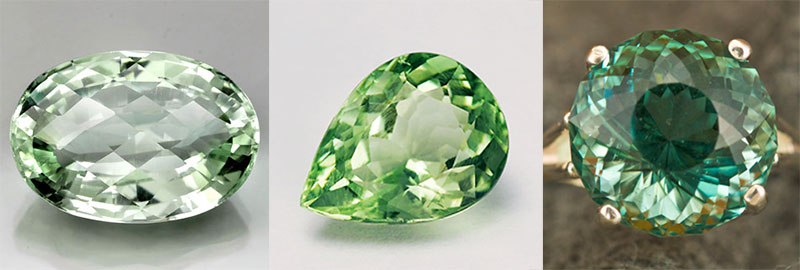Prasiolite gemstone
Home ➤ Encyclopedia of gems ➤ Prasiolite gemstonePhysical properties of prasiolite
| Hardness: | 7 out of 10 on the Mohs scale |
| Luster: | glass |
| Transparency: | transparent, translucent |
| Color: | light green, onion green |
Prasiolite characteristics
Prasiolite gemstone (green quartz, emerald quartz, Indian emerald, green amethyst, vermarine, chrysoquartz, peridine) is worth talking about, if only because there is too much conflicting information about this stone.
Prasiolite got its name from the Greek word "prazios", which means "leek". So the stone was named for its "onion" (that is, light green) color. Prasiolite is a variety of quartz, and since quartz is not a very expensive stone, prasiolites from ancient times have constantly tried to pass off as other (more valuable) green stones - emeralds, tourmalines, beryl and peridots. Or, in order to raise the price of prasiolite, sellers came up with beautiful names for this stone, like “emerald quartz”, “Indian emerald”, “chrysoquartz” (by association with chrysoberyl), “green amethyst” and others.

Although prasiolites are quite good in terms of their quality characteristics - they are quite hard, have good transparency, are quite large and have a good color range - green, pale green (to almost colorless), emerald green, lemon.
Some sources claim that natural prasiolite does not exist in nature and that all prasiolites are obtained through artificial processing. However, natural prasiolites do exist. They are rare, but deposits of natural prasiolites have been found in Russia, Brazil, Poland, the USA, India and other places. True, the minus of natural prasiolites is that they can lose color from exposure to sunlight and thus turn into rock crystal.
However, for a very long time, mankind has learned to create artificial prasiolites - usually with the help of simple temperature exposure. And a lot of these stones have been sold and are being sold to this day, since it is not easy to distinguish natural from artificial prasiolite without special equipment - all stones look equally beautiful. The only difference is the price, since artificial prasiolites are made from cheaper raw materials - yellowish varieties of quartz and amethysts. Although, of course, artificial prasiolites are often sold as natural ones. Therefore, it is better to buy jewelry with prasiolites from reliable companies that care about their reputation.
How much does prasiolite cost
The price of natural prasiolite is low - from 20 to 100 dollars per carat, depending on the quality. A natural prasiolite ring will cost between $100 and $200.
However, natural prasiolite is rare. Much more often they sell artificial prasiolites under the guise of natural. Their cost is much lower - about $10 per carat. A ring with artificial prasiolite will cost only 25-30 dollars, earrings - 50-60 dollars.
| ★ Turquoise gemstone | |
| See also: | ★ Larimar gemstone |
| ★ Kyanite gemstone |





